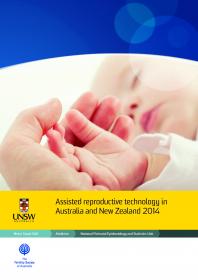
Assisted reproductive technology (ART) is a group of procedures that involve the in vitro (outside of body) handling of human oocytes (eggs) and sperm or embryos for the purposes of establishing a pregnancy. Each ART treatment involves a number of stages and is generally referred to as an ART treatment cycle. The embryos transferred to a women can either originate from the cycle in which they were created (fresh cycle) or be frozen and thawed before transfer (thaw cycle).
There were 73,598 ART treatment cycles reported from Australian and New Zealand clinics in 2014 (67,707 and 5,891 respectively) representing a 2.4% increase in Australia and 9.6% increase in New Zealand on 2013. This represented 13.9 cycles per 1,000 women of reproductive age (15–44 years) in Australia, compared with 6.5 cycles per 1,000 women of reproductive age in New Zealand. Women used their own oocytes or embryos (autologous cycles) in 94.6% of treatments. Embryos that had been frozen and thawed where used in 37.4% of autologous cycles.
There were 37,281 women who undertook 69,638 autologous fresh and/or thaw cycles in Australia and New Zealand in 2014. On average, 1.8 fresh and/or thaw cycles per woman were undertaken in 2014, with more cycles per woman in Australia (1.9 cycles per woman) than in New Zealand (1.5 cycles per woman).The number of cycles where embryos were selected using preimplantation genetic diagnosis (PGD) increased from 2,740 in 2013 to 3,448 in 2014 (25.8% increase)
Over the last five years there has been an increasing trend in the proportion of cycles where all oocytes or embryos are cryopreserved for potential future use (freeze-all cycles) from 4.1% of initiated fresh cycles in 2010 to 13.0% of initiated fresh cycles in 2014. This practice reduces the risk of ovarian hyperstimulation syndrome (OHSS)in some patients, is often used in conjunction with PGD and fertility preservation, and is a deliberate treatment option used by some clinicians.
The average age of women undergoing autologous cycles was 35.8 years in 2014, similar to previous years. The average age of women undergoing ART treatment using donor oocytes or embryos was approximately five years older at 40.4 years. Approximately, one in four (25.5%) women who underwent an autologous cycle in 2014 was aged 40 or older. The average age of the male partner of the women undergoing autologous and recipient cycles was 38.2 years, with one-third (34.8%) aged 40 or older.
Of the 73,598 initiated cycles, 23.7% (17,427) resulted in a clinical pregnancy and 18.2% (13,373) in a live delivery. The overall clinical pregnancy rate for cycles reaching embryo transfer was 31.6%. The live delivery rate per initiated autologous fresh cycle was 15.3%, and 17.7% after freeze-all cycles were excluded. The live delivery rate for fresh cycles reaching embryo transfer was 23.5%. The live delivery rate per initiated thaw cycle was 23.6% and for thaw cycles reaching embryo transfer cycle was 25.2%.
There was a higher live delivery rate in younger women. For women aged under 30, the live delivery rate per embryo transfer was 38.7% for autologous fresh cycles and 29.5 % for autologous thaw cycles. For women aged over 44, the live delivery rate was 1.2% and 7.9% per embryo transfer for autologous fresh and thaw cycles.
There were 14,238 babies born (including 14,016 liveborn babies) following ART treatment in 2014. Of these, 12,875 (90.4%) were from Australian clinics and 1,363 (9.6%) from New Zealand clinics. Over three-quarters of the liveborn babies (78.1%) were full-term singletons of normal birthweight.
ANZARD includes data items that make it possible to follow a woman’s consecutive ART treatment cycles. A cohort of 15,055 women were followed from the start of their first autologous non freeze-all fresh cycle during 2012, through subsequent fresh and thaw cycles until December 2014 or until they achieved a live delivery. The cycle-specific live delivery rate per initiated cycle for all women was 22.8% in their first cycle, and around 9.0% after eight cycles. For women aged 30-34 the cycle-specific live delivery rate was 30.0% in the first cycle and around 23% in the following six cycles. Of women who did not achieve a live birth in a specific cycle, approximately one in four did not return for further ART treatment.
Treatment trends in the last five years have shown a shift from cleavage stage transfers to blastocyst transfers from 52.1% in 2010 to 67.5% in 2014; an increase in vitrification as a cryopreservation method from 62.6% of thaw blastocyst transfer cycles in 2010 to 85.6% in 2014. The use intracytoplasmic sperm injection (ICSI) has remained stable at around 63.0% of embryo transfer cycles in 2010-2014.
The proportion of embryo transfer cycles transferring a cryopreserved embryo increased from 41.0% of embryo transfer cycles in 2010 to 47.1% in 2014.
In the last five years the live delivery rate per fresh embryo transfer cycle remained stable around 23.0%, while the live delivery rate per frozen/thaw embryo transfer cycle increased from 20.0% to 24.9%. Overall the live birth rate per initiated cycle has increased by almost 10% from 18.1% in 2011 to 19.8% for 2014.
A continuing trend in ART treatment in Australia and New Zealand has been the reduction in the rate of multiple deliveries, with a 38% decrease from 7.9% in 2010 to 4.9% in 2014. This was achieved by clinicians and patients shifting to single embryo transfer, with the proportion increasing from 69.6% in 2010 to 82.9% in 2014. Importantly, this decrease in the multiple delivery rate was achieved while overall live delivery rates per embryo transfer increased from 22.1% in 2010 to 24.3% in 2014.